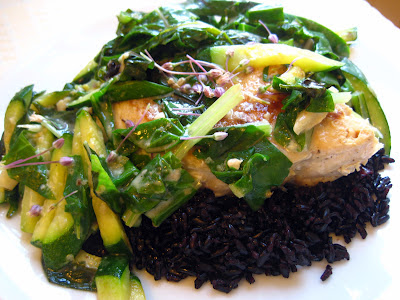I am, at present, approximately 37 parts ecstatic to 2 parts distraught. C'est la vie, you will say, if you are prone to saying things in French while browsing online—it's happiness and sadness, the yin and the yang, the pot and the kettle—you can't have one without the other. But I maintain that, had someone informed me earlier that you can grill pizza, the two parts distraught could have been entirely avoided.
As it is, I am left to bask happily in the warm grilled glow of warm grilled pizza, smiling dazedly in delight, planning future multitudes of grilled pizza evenings...while heroically trying to overcome the terrible knowledge of the lost opportunities of ungrilled pizzas past.
If you'd care to join me, I'll be jubilantly drowning my sorrows in a slice of grilled pizza. Did I mention? It's possibly probably the most amazing thing on earth.
Ingredients
Crust:
1 tsp dry active yeast
1/2 cup warm water (about 110 degrees F)
1/4 tsp sugar
1 tbsp olive oil
1/2 cup plus 2 tbsp stone-ground whole wheat bread flour
3/4 cups unbleached all-purpose flour
1/2 tsp plus one pinch salt
3 pinches chopped fresh rosemary leaves (2-3 sprigs)
2 pinches lemon zest (grated on a microplane, else very finely minced)
Coarsely-ground cornmeal
Olive oil for brushing
Top:
1 small clove garlic, pressed
4 oz grated Monterey jack cheese
A little grated parmesan
2 oz prosciutto
1 peach, halved along the seam, cut side dipped lightly in granulated sugar, and grilled
2 handfuls baby arugula, divided
Pinch chopped rosemary
3 tbsp balsamic vinegar
Black pepper to top (optional)
Follow the instructions in this recipe to prepare the pizza dough (or use store-bought dough if you must, but making your own is easier than you think, way healthier, and deeply delectable).
After you grill the peaches, leave your grill set on high. Let the peach halves cool for a few minutes, then slice fairly thinly.
Meanwhile, heat 3 tbsp balsamic vinegar in a small pot over medium-low heat. Simmer until volume is reduced by half, then remove from the heat and set aside. Make sure the rest of the toppings are prepared and ready to go, so that you can top the pizza quickly (the cheese needs to melt from the heat of the grilled crust).
Sprinkle a wooden cutting board with cornmeal. Take the pizza dough out of the bowl and gently form a ball, then place on the cutting board and begin gently pressing and stretching it outward to form a flat pancake. You want to end up with a flat disc that's about 12" in diameter.
Lightly flour a rimless cookie sheet, pizza peel, or one of those flexible plastic cutting boards. Flip the disk of pizza dough onto it so the cornmeal side is facing up.
Ball up a paper towel tightly, dip it in olive oil, and use tongs to wipe it across the grill.* Slide the pizza (cornmeal side up) onto the oiled grill and close the lid. Grill for 2-3 minutes, until the crust bubbles on the top. When it starts to bubble, lift up one side of the crust to check underneath for grill marks; when the grill marks are dark brown or starting to blacken, slide back onto the cookie sheet or pizza peel or a wooden cutting board (don’t use the plastic one now that the pizza is hot).
Working quickly, flip the pizza cornmeal side down (so that the grilled side is face up). Brush lightly with olive oil and rub with the garlic. Sprinkle with cheese, then layer with prosciutto and peaches. Scatter a handful of arugula over the top, and sprinkle with a pinch of chopped rosemary.
Turn the heat down slightly and return the pizza to the grill for 3-4 minutes, covered, until the prosciutto just starts to curl and the bottom of the pizza looks toasty and brown (it will start to blacken in a few spots as well).
Remove with the pizza peel or cookie sheet, slide onto a wooden cutting board, slice with a pizza slicer, and drizzle with balsamic reduction. Scatter another handful of arugula over the top, sprinkle lightly with freshly ground black pepper, and serve hot.
Serves 2.
*This trick and most of the know-how for pizza grilling courtesy of the instructions here.








































